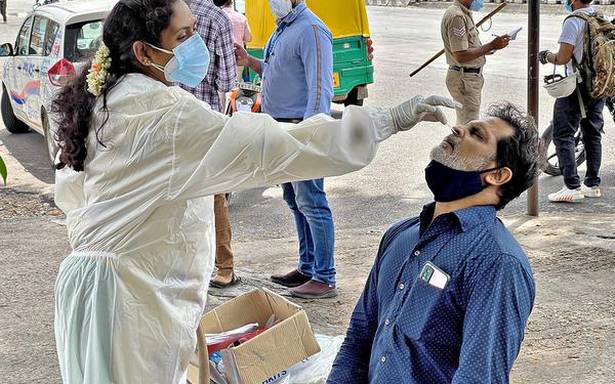Mutant variants, gaps in tracing, and isolation strategies suspected to be reasons for high TPR
Confounded by the high Test Positivity Rate (TPR) in Mysuru, which is the only district in Karnataka to continue with the tough lockdown restrictions, public health experts are suspecting mutant variants of the COVID-19 virus, besides gaps in tracing and home isolation strategies as being among the reasons for the high transmission rate in the district.
The TPR, which is considered by the State government as a barometer for revising the lockdown restrictions in the State in accordance with the recommendations of its COVID-19 Technical Advisory Committee (TAC), was 12.11% in Mysuru, as against the State average of 4.14% in the seven days prior to June 19.
Though the TPR as well as the number of daily infections had come down substantially in Mysuru over the past one month, the rate of decline has been much slower than that in the rest of the State. Consequently, Mysuru has the dubious distinction of being the only district in the State where the lockdown restrictions have not been relaxed.
Nanjaraj, Dean and Director of Mysore Medical College and Research Institute (MMC&RI), told The Hindu that samples of COVID-19 patients from Mysuru have been sent to the genome sequencing laboratory at the National Institute of Mental Health and Neurosciences, Bengaluru. “We will know the variant only when it is announced,” he said.
However, Mudassir Azeez Khan, head of Community Medicine at MMC&RI, strongly suspects the “infectious” Delta variant to have played a role in the high transmission rate in Mysuru. “From an epidemiological observation, I can say that the Delta variant may be involved here. But the evidence should come from genomic sequencing,” he said. Dr. Khan described the Delta variant to be “one and a half times” more infectious. “That could be the reason for most family members turning positive when one person turns positive.”
Dr. Nanjaraj, who is also the nodal officer of the COVID-19 Trauma Care Centre in Mysuru, said doctors had observed an unusually high spike in glucose levels amongst even non-diabetic COVID-19 patients. “The blood glucose levels reached alarmingly high levels of 600 to 700 in a few patients,” he said, suspecting the mutant variant of attacking the pancreatic cells.
Gaps in strategy
Gaps in testing, tracing and isolation strategies were also identified by Dr. Khan to be among the reasons for the challenges faced by the authorities taming the transmission rate in the district.
The number of tests in the district was brought down from 6,000 to 7,000 daily till April to 3,500 to 4,000 daily in May. But, the number of tests was increased in the first week of June to 6,000 to 8,000 a day.
Newly appointed Mysuru District Health Officer K.H. Prasad attributed the high TPR to “qualitative” testing. “We are focussing our testing on a population that has a high probability of COVID-19. Hence, the higher TPR,” he reasoned.
But he admitted that the authorities were unable to adequately trace primary contacts. “For each positive patient, there will be at least eight to 10 primary contacts. But on most occasions, the positive patients do not reveal the details of their primary contacts honestly,” he said.
Also, many COVID-19 positive patients who had to isolate themselves at home were not following the instructions, leading to greater transmission of the virus. In view of the complaints about violation of home isolation protocols by many patients, Mysuru District Surveillance Officer Shivaprasad said the authorities we now planning to shift them to COVID-19 Care Centres.
Source: Read Full Article

